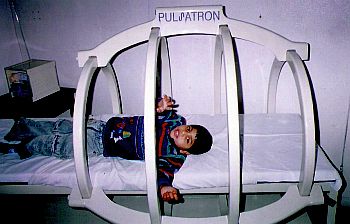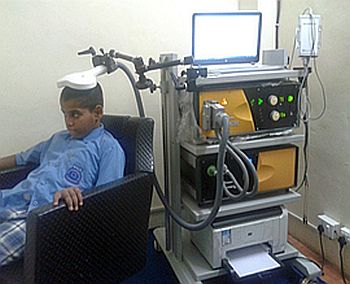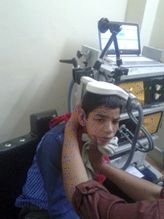In the mid 2000s, PMFT was tried in 6 Spastic CP Children who were on Standard Therapy ONLY, whose parents wanted to try this therapy.
The children were placed inside the series of ring shaped electromagnetic coils as shown in the picture. The duration of each session was half an hour.
The benefits were observed up to six months. rTMS is an advance on PMFT, as it ises a ring shaped coil over the affected area of brain as identified by clinical evaluation and SPECT Hybrid Scan.
rTMS is an effective , non invasive and pain free alternative for the large number of patients not responding to medication or who cannot tolerate side effects of medication.It does not require any anesthesia.
Clinical trial and experience from clinics offering this treatment show excellent result in term of response rate or even complete remission. This system delivered magnetic pulses to stimulate nerve cells in the part of the brain controlling the mood and various brain activities. During this treatment the machine is connected with the patented scale to deliver the magnetic pulses to the human brain cortex through scalp via placing the magnetic coil on human skull as shown.
rTMS is the new intervention techniques for treating various psychological and neurological conditions like depression, stroke and dementia. This is clinically approved by Food and Drug Administration of USA, for many neurological conditions.
We are using this technique to improve the physical function in spastic cerebral palsy patient to improve their quality of life where only rehabilitation is the way to make them independent. The approach of this technique with the standard therapies like physical and occupational therapy increase the rate of improvement in the cerebral palsy patient.
Emphasis on RTMS
There is no need to take anesthesia and oral medication to use RTMS. It has deep penetration which excitates the neuron of brain cell and its non invasive technique of treatment in Spastic cerebral palsy which is approved by Food and Drug Administration.Mode of Action
RTMS excited the brain cells and neurons which generate new pathways in hypoxic brain and helps in Neuroplasticity
Major Clinical therapeutic uses
|
|


